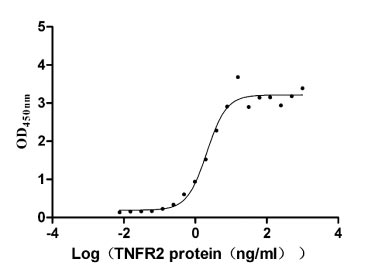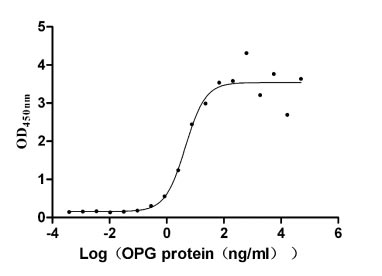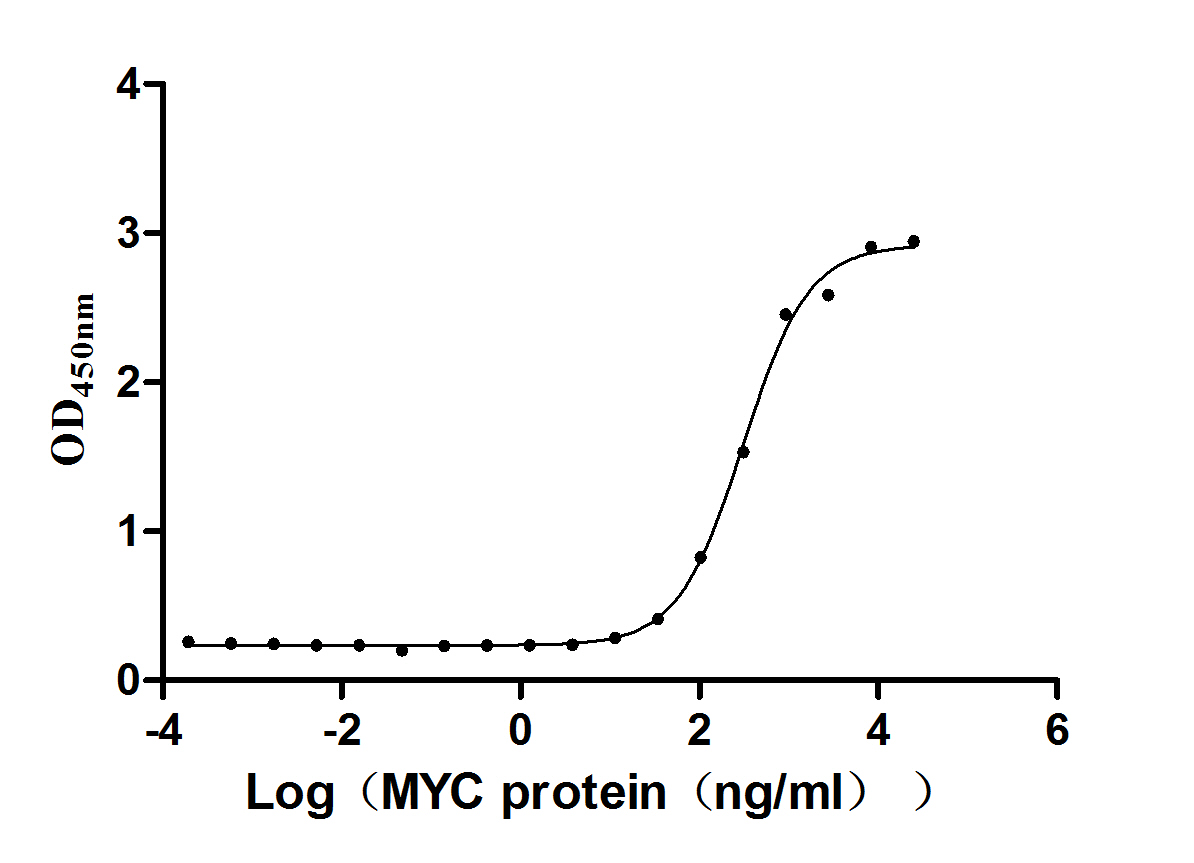Recombinant Human herpesvirus 8 type P E3 ubiquitin-protein ligase MIR2 (K5), partial
-
中文名称:Recombinant Human herpesvirus 8 type P E3 ubiquitin-protein ligase MIR2(K5),partial,Yeast
-
货号:CSB-YP310858HKE
-
规格:
-
来源:Yeast
-
其他:
-
中文名称:Recombinant Human herpesvirus 8 type P E3 ubiquitin-protein ligase MIR2(K5),partial,Yeast
-
货号:CSB-EP310858HKE
-
规格:
-
来源:E.coli
-
其他:
-
中文名称:Recombinant Human herpesvirus 8 type P E3 ubiquitin-protein ligase MIR2(K5),partial,Yeast
-
货号:CSB-EP310858HKE-B
-
规格:
-
来源:E.coli
-
共轭:Avi-tag Biotinylated
E. coli biotin ligase (BirA) is highly specific in covalently attaching biotin to the 15 amino acid AviTag peptide. This recombinant protein was biotinylated in vivo by AviTag-BirA technology, which method is BriA catalyzes amide linkage between the biotin and the specific lysine of the AviTag.
-
其他:
-
中文名称:Recombinant Human herpesvirus 8 type P E3 ubiquitin-protein ligase MIR2(K5),partial,Yeast
-
货号:CSB-BP310858HKE
-
规格:
-
来源:Baculovirus
-
其他:
-
中文名称:Recombinant Human herpesvirus 8 type P E3 ubiquitin-protein ligase MIR2(K5),partial,Yeast
-
货号:CSB-MP310858HKE
-
规格:
-
来源:Mammalian cell
-
其他:
产品详情
-
纯度:>85% (SDS-PAGE)
-
基因名:K5
-
Uniprot No.:
-
别名:K5E3 ubiquitin-protein ligase MIR2; EC 2.3.2.27; IE1A protein; Modulator of immune recognition 2; ORF K5; RING-type E3 ubiquitin transferase MIR2
-
种属:Human herpesvirus 8 type P (isolate GK18) (HHV-8) (Kaposi's sarcoma-associated herpesvirus)
-
蛋白长度:Partial
-
蛋白标签:Tag type will be determined during the manufacturing process.
The tag type will be determined during production process. If you have specified tag type, please tell us and we will develop the specified tag preferentially. -
产品提供形式:Lyophilized powder
Note: We will preferentially ship the format that we have in stock, however, if you have any special requirement for the format, please remark your requirement when placing the order, we will prepare according to your demand. -
复溶:We recommend that this vial be briefly centrifuged prior to opening to bring the contents to the bottom. Please reconstitute protein in deionized sterile water to a concentration of 0.1-1.0 mg/mL.We recommend to add 5-50% of glycerol (final concentration) and aliquot for long-term storage at -20℃/-80℃. Our default final concentration of glycerol is 50%. Customers could use it as reference.
-
储存条件:Store at -20°C/-80°C upon receipt, aliquoting is necessary for mutiple use. Avoid repeated freeze-thaw cycles.
-
保质期:The shelf life is related to many factors, storage state, buffer ingredients, storage temperature and the stability of the protein itself.
Generally, the shelf life of liquid form is 6 months at -20°C/-80°C. The shelf life of lyophilized form is 12 months at -20°C/-80°C. -
货期:Delivery time may differ from different purchasing way or location, please kindly consult your local distributors for specific delivery time.Note: All of our proteins are default shipped with normal blue ice packs, if you request to ship with dry ice, please communicate with us in advance and extra fees will be charged.
-
注意事项:Repeated freezing and thawing is not recommended. Store working aliquots at 4°C for up to one week.
-
Datasheet :Please contact us to get it.
靶点详情
-
功能:E3 ubiquitin-protein ligase which promotes ubiquitination and subsequent degradation of host MHC-I, CD86, ICAM1 and CD1D molecules, presumably to prevent lysis of infected cells by cytotoxic T-lymphocytes and NK cell. Binds target molecules through transmembrane interaction. E3 ubiquitin-protein ligases accept ubiquitin from specific E2 ubiquitin-conjugating enzymes, and then transfer it to target protein. The result of this ubiquitination is the enhancement of the endocytosis of the target chain and the delivery to the lysosome, where it is proteolytically destroyed. Specific for HLA-A and HLA-B2 alleles.
-
基因功能参考文献:
- This work ascribes a critical function to PLP2 for viral ligase activity and underlines the power of non-lethal haploid genetic screens in human cells to identify the genes involved in pathogen manipulation of the host immune system. PMID: 24278019
- Both K3 and K5 preferentially associate with DC-SIGN and DC-SIGNR, mediating their ubiquitylation and degradation. PMID: 23460925
- Phe119 and Ser120 in the MIR2 ITM region and Asp244 in the B7-2 JM region contribute to the recognition of B7-2 by MIR2. PMID: 22379101
- We provide evidence that the KSHV K5 protein is able to drive alterations in cellular signaling cascades, potentially contributing to KSHV oncogenesis. PMID: 21490960
- Palmitoylation act to regulate MIR2 function and localization during viral infection. PMID: 21159884
- Data show that the polyubiquitin chain generated by the viral E3 ubiquitin ligase, MIR2, is a Lys(11) and Lys(63) mixed-linkage chain, and this ubiquitin chain can function as an internalization signal for MHC I. PMID: 20833710
- K5-mediated inhibition of the capture of effector memory CD4-positive T cells can be explained by ubiquitin-dependent downregulation of ICAM-1 expression. PMID: 20357254
- K5 is a mechanistically distinct viral countermeasure to tetherin-mediated restriction PMID: 20419159
- these results suggest that the effects of MIR2 are gene dosage dependent and that low levels of this viral protein contribute to the widespread downregulation of immune-modulating cell surface proteins during the initial stages of KSHV infection PMID: 17329329
- while K5 can act as an E3 ubiquitin ligase to directly mediate cell surface molecule destruction, regulation of its targets occurs through multiple pathways, including ubiquitin-independent mechanisms PMID: 17409151
- K5-mediated ubiquitylation signals internalization but not degradation of MICA and causes a potent reduction in NK cell-mediated cytotoxicity. PMID: 18230726
- KSHV release is decreased in the absence of K5 in a BST2-dependent manner, suggesting that K5 contributes to the evasion of intracellular antiviral defense programs PMID: 19605472
显示更多
收起更多
-
亚细胞定位:Host cell membrane; Multi-pass membrane protein. Host endoplasmic reticulum. Note=Probably exerts its effects at the plasma membrane during viral infection.
-
数据库链接:
KEGG: vg:4961442
Most popular with customers
-
Recombinant Macaca fascicularis Angiotensin-converting enzyme (ACE2), partial (Active)
Express system: Mammalian cell
Species: Macaca fascicularis (Crab-eating macaque) (Cynomolgus monkey)
-
Recombinant Human Lymphotoxin-alpha (LTA) (Active)
Express system: Mammalian cell
Species: Homo sapiens (Human)
-
Recombinant Human Tumor necrosis factor receptor superfamily member 11B (TNFRSF11B) (Active)
Express system: Mammalian cell
Species: Homo sapiens (Human)
-
Recombinant Human papillomavirus type 16 Protein E7 (E7) (Active)
Express system: E.coli
Species: Human papillomavirus type 16
-
Recombinant Human Insulin growth factor-like family member 1 (IGFL1) (Active)
Express system: Mammalian cell
Species: Homo sapiens (Human)
-
Recombinant Human B-lymphocyte antigen CD20 (MS4A1)-VLPs (Active)
Express system: Mammalian cell
Species: Homo sapiens (Human)
-
Recombinant Rat Intestinal-type alkaline phosphatase 1 (Alpi) (Active)
Express system: Mammalian cell
Species: Rattus norvegicus (Rat)
-
Recombinant Human Complement component C1q receptor (CD93), partial (Active)
Express system: Mammalian cell
Species: Homo sapiens (Human)




















